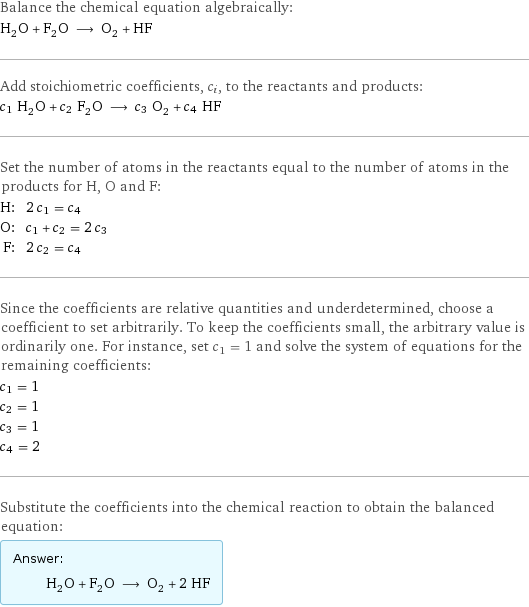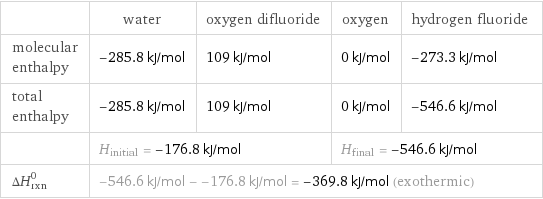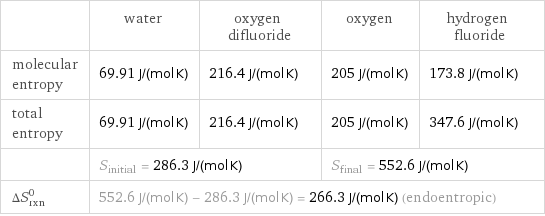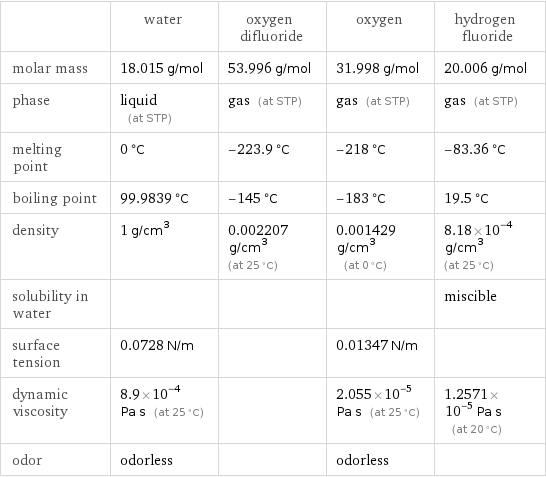Input interpretation

H_2O water + F_2O oxygen difluoride ⟶ O_2 oxygen + HF hydrogen fluoride
Balanced equation

Balance the chemical equation algebraically: H_2O + F_2O ⟶ O_2 + HF Add stoichiometric coefficients, c_i, to the reactants and products: c_1 H_2O + c_2 F_2O ⟶ c_3 O_2 + c_4 HF Set the number of atoms in the reactants equal to the number of atoms in the products for H, O and F: H: | 2 c_1 = c_4 O: | c_1 + c_2 = 2 c_3 F: | 2 c_2 = c_4 Since the coefficients are relative quantities and underdetermined, choose a coefficient to set arbitrarily. To keep the coefficients small, the arbitrary value is ordinarily one. For instance, set c_1 = 1 and solve the system of equations for the remaining coefficients: c_1 = 1 c_2 = 1 c_3 = 1 c_4 = 2 Substitute the coefficients into the chemical reaction to obtain the balanced equation: Answer: | | H_2O + F_2O ⟶ O_2 + 2 HF
Structures

+ ⟶ +
Names

water + oxygen difluoride ⟶ oxygen + hydrogen fluoride
Reaction thermodynamics
Enthalpy

| water | oxygen difluoride | oxygen | hydrogen fluoride molecular enthalpy | -285.8 kJ/mol | 109 kJ/mol | 0 kJ/mol | -273.3 kJ/mol total enthalpy | -285.8 kJ/mol | 109 kJ/mol | 0 kJ/mol | -546.6 kJ/mol | H_initial = -176.8 kJ/mol | | H_final = -546.6 kJ/mol | ΔH_rxn^0 | -546.6 kJ/mol - -176.8 kJ/mol = -369.8 kJ/mol (exothermic) | | |
Gibbs free energy

| water | oxygen difluoride | oxygen | hydrogen fluoride molecular free energy | -237.1 kJ/mol | 105.3 kJ/mol | 231.7 kJ/mol | -275.4 kJ/mol total free energy | -237.1 kJ/mol | 105.3 kJ/mol | 231.7 kJ/mol | -550.8 kJ/mol | G_initial = -131.8 kJ/mol | | G_final = -319.1 kJ/mol | ΔG_rxn^0 | -319.1 kJ/mol - -131.8 kJ/mol = -187.3 kJ/mol (exergonic) | | |
Entropy

| water | oxygen difluoride | oxygen | hydrogen fluoride molecular entropy | 69.91 J/(mol K) | 216.4 J/(mol K) | 205 J/(mol K) | 173.8 J/(mol K) total entropy | 69.91 J/(mol K) | 216.4 J/(mol K) | 205 J/(mol K) | 347.6 J/(mol K) | S_initial = 286.3 J/(mol K) | | S_final = 552.6 J/(mol K) | ΔS_rxn^0 | 552.6 J/(mol K) - 286.3 J/(mol K) = 266.3 J/(mol K) (endoentropic) | | |
Equilibrium constant
![Construct the equilibrium constant, K, expression for: H_2O + F_2O ⟶ O_2 + HF Plan: • Balance the chemical equation. • Determine the stoichiometric numbers. • Assemble the activity expression for each chemical species. • Use the activity expressions to build the equilibrium constant expression. Write the balanced chemical equation: H_2O + F_2O ⟶ O_2 + 2 HF Assign stoichiometric numbers, ν_i, using the stoichiometric coefficients, c_i, from the balanced chemical equation in the following manner: ν_i = -c_i for reactants and ν_i = c_i for products: chemical species | c_i | ν_i H_2O | 1 | -1 F_2O | 1 | -1 O_2 | 1 | 1 HF | 2 | 2 Assemble the activity expressions accounting for the state of matter and ν_i: chemical species | c_i | ν_i | activity expression H_2O | 1 | -1 | ([H2O])^(-1) F_2O | 1 | -1 | ([F2O])^(-1) O_2 | 1 | 1 | [O2] HF | 2 | 2 | ([HF])^2 The equilibrium constant symbol in the concentration basis is: K_c Mulitply the activity expressions to arrive at the K_c expression: Answer: | | K_c = ([H2O])^(-1) ([F2O])^(-1) [O2] ([HF])^2 = ([O2] ([HF])^2)/([H2O] [F2O])](../image_source/4e692b3b464d8b148a8742a860e2de2b.png)
Construct the equilibrium constant, K, expression for: H_2O + F_2O ⟶ O_2 + HF Plan: • Balance the chemical equation. • Determine the stoichiometric numbers. • Assemble the activity expression for each chemical species. • Use the activity expressions to build the equilibrium constant expression. Write the balanced chemical equation: H_2O + F_2O ⟶ O_2 + 2 HF Assign stoichiometric numbers, ν_i, using the stoichiometric coefficients, c_i, from the balanced chemical equation in the following manner: ν_i = -c_i for reactants and ν_i = c_i for products: chemical species | c_i | ν_i H_2O | 1 | -1 F_2O | 1 | -1 O_2 | 1 | 1 HF | 2 | 2 Assemble the activity expressions accounting for the state of matter and ν_i: chemical species | c_i | ν_i | activity expression H_2O | 1 | -1 | ([H2O])^(-1) F_2O | 1 | -1 | ([F2O])^(-1) O_2 | 1 | 1 | [O2] HF | 2 | 2 | ([HF])^2 The equilibrium constant symbol in the concentration basis is: K_c Mulitply the activity expressions to arrive at the K_c expression: Answer: | | K_c = ([H2O])^(-1) ([F2O])^(-1) [O2] ([HF])^2 = ([O2] ([HF])^2)/([H2O] [F2O])
Rate of reaction
![Construct the rate of reaction expression for: H_2O + F_2O ⟶ O_2 + HF Plan: • Balance the chemical equation. • Determine the stoichiometric numbers. • Assemble the rate term for each chemical species. • Write the rate of reaction expression. Write the balanced chemical equation: H_2O + F_2O ⟶ O_2 + 2 HF Assign stoichiometric numbers, ν_i, using the stoichiometric coefficients, c_i, from the balanced chemical equation in the following manner: ν_i = -c_i for reactants and ν_i = c_i for products: chemical species | c_i | ν_i H_2O | 1 | -1 F_2O | 1 | -1 O_2 | 1 | 1 HF | 2 | 2 The rate term for each chemical species, B_i, is 1/ν_i(Δ[B_i])/(Δt) where [B_i] is the amount concentration and t is time: chemical species | c_i | ν_i | rate term H_2O | 1 | -1 | -(Δ[H2O])/(Δt) F_2O | 1 | -1 | -(Δ[F2O])/(Δt) O_2 | 1 | 1 | (Δ[O2])/(Δt) HF | 2 | 2 | 1/2 (Δ[HF])/(Δt) (for infinitesimal rate of change, replace Δ with d) Set the rate terms equal to each other to arrive at the rate expression: Answer: | | rate = -(Δ[H2O])/(Δt) = -(Δ[F2O])/(Δt) = (Δ[O2])/(Δt) = 1/2 (Δ[HF])/(Δt) (assuming constant volume and no accumulation of intermediates or side products)](../image_source/89f388cc0515ba7c9704f94d881787c2.png)
Construct the rate of reaction expression for: H_2O + F_2O ⟶ O_2 + HF Plan: • Balance the chemical equation. • Determine the stoichiometric numbers. • Assemble the rate term for each chemical species. • Write the rate of reaction expression. Write the balanced chemical equation: H_2O + F_2O ⟶ O_2 + 2 HF Assign stoichiometric numbers, ν_i, using the stoichiometric coefficients, c_i, from the balanced chemical equation in the following manner: ν_i = -c_i for reactants and ν_i = c_i for products: chemical species | c_i | ν_i H_2O | 1 | -1 F_2O | 1 | -1 O_2 | 1 | 1 HF | 2 | 2 The rate term for each chemical species, B_i, is 1/ν_i(Δ[B_i])/(Δt) where [B_i] is the amount concentration and t is time: chemical species | c_i | ν_i | rate term H_2O | 1 | -1 | -(Δ[H2O])/(Δt) F_2O | 1 | -1 | -(Δ[F2O])/(Δt) O_2 | 1 | 1 | (Δ[O2])/(Δt) HF | 2 | 2 | 1/2 (Δ[HF])/(Δt) (for infinitesimal rate of change, replace Δ with d) Set the rate terms equal to each other to arrive at the rate expression: Answer: | | rate = -(Δ[H2O])/(Δt) = -(Δ[F2O])/(Δt) = (Δ[O2])/(Δt) = 1/2 (Δ[HF])/(Δt) (assuming constant volume and no accumulation of intermediates or side products)
Chemical names and formulas

| water | oxygen difluoride | oxygen | hydrogen fluoride formula | H_2O | F_2O | O_2 | HF Hill formula | H_2O | F_2O | O_2 | FH name | water | oxygen difluoride | oxygen | hydrogen fluoride IUPAC name | water | fluoro hypofluorite | molecular oxygen | hydrogen fluoride
Substance properties

| water | oxygen difluoride | oxygen | hydrogen fluoride molar mass | 18.015 g/mol | 53.996 g/mol | 31.998 g/mol | 20.006 g/mol phase | liquid (at STP) | gas (at STP) | gas (at STP) | gas (at STP) melting point | 0 °C | -223.9 °C | -218 °C | -83.36 °C boiling point | 99.9839 °C | -145 °C | -183 °C | 19.5 °C density | 1 g/cm^3 | 0.002207 g/cm^3 (at 25 °C) | 0.001429 g/cm^3 (at 0 °C) | 8.18×10^-4 g/cm^3 (at 25 °C) solubility in water | | | | miscible surface tension | 0.0728 N/m | | 0.01347 N/m | dynamic viscosity | 8.9×10^-4 Pa s (at 25 °C) | | 2.055×10^-5 Pa s (at 25 °C) | 1.2571×10^-5 Pa s (at 20 °C) odor | odorless | | odorless |
Units
